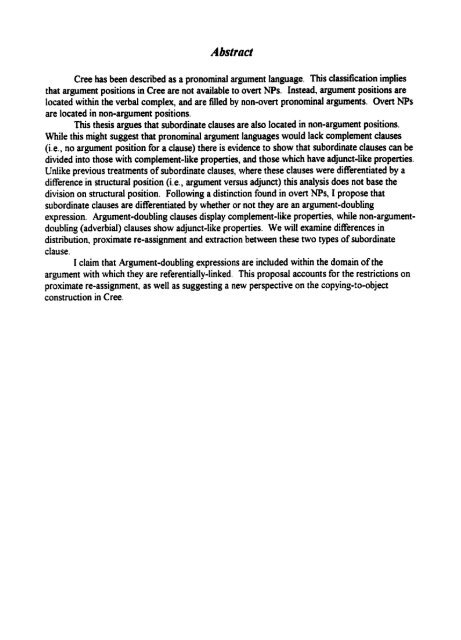Adverbial and Argument-Doubling Clauses in Cree - MSpace
Adverbial and Argument-Doubling Clauses in Cree - MSpace
Adverbial and Argument-Doubling Clauses in Cree - MSpace
You also want an ePaper? Increase the reach of your titles
YUMPU automatically turns print PDFs into web optimized ePapers that Google loves.
<strong>Cree</strong> has been described as a pronom<strong>in</strong>al argument language. This classification implies<br />
that argument positions <strong>in</strong> <strong>Cree</strong> are not available to overt NPs. Instead, argument positions are<br />
located with<strong>in</strong> the verbal cornplex, <strong>and</strong> are filled by non-overt pronom<strong>in</strong>al arguments. Overt NPs<br />
are located <strong>in</strong> non-argument positions.<br />
This thesis argues that subord<strong>in</strong>ate clauses are also located <strong>in</strong> non-argument positions.<br />
While this might suggest that pronom<strong>in</strong>al argument languages would lack complement clauses<br />
(i.e., no argument position for a clause) there is evidence to show that subord<strong>in</strong>ate clauses can be<br />
divided <strong>in</strong>to those with complement-like properties, <strong>and</strong> those which have adjunct-like properties.<br />
Unlike previous treatments of subord<strong>in</strong>ate clauses, where these clauses were differentiated by a<br />
difference <strong>in</strong> structural position (i.e., argument versus adjunct) this analysis does not base the<br />
division on structural position. Follow<strong>in</strong>g a dist<strong>in</strong>ction found <strong>in</strong> overt NPs, I propose that<br />
subord<strong>in</strong>ate clauses are differentiated by whether or not they are an argument-doubl<strong>in</strong>g<br />
expression. <strong>Argument</strong>-doubl<strong>in</strong>g clauses display complement-like properties, while non-argumentdoubl<strong>in</strong>g<br />
(adverbial) clauses show adjunct-like properties. We will exam<strong>in</strong>e differences <strong>in</strong><br />
distribution, proximate re-assignment <strong>and</strong> extraction between thex two types of subord<strong>in</strong>ate<br />
clause.<br />
1 daim that <strong>Argument</strong>-doubl<strong>in</strong>g expressions are <strong>in</strong>cluded with<strong>in</strong> the doma<strong>in</strong> of the<br />
argument with which they are referentially-l<strong>in</strong>ked. This proposai accounts for the restrictions on<br />
proximate re-assignment, as well as suggest<strong>in</strong>g a new perspective on the copy<strong>in</strong>g-to-object<br />
construction <strong>in</strong> <strong>Cree</strong>.








![an unusual bacterial isolate from in partial fulf]lment for the ... - MSpace](https://img.yumpu.com/21942008/1/190x245/an-unusual-bacterial-isolate-from-in-partial-fulflment-for-the-mspace.jpg?quality=85)




![in partial fulfil]ment of the - MSpace - University of Manitoba](https://img.yumpu.com/21941988/1/190x245/in-partial-fulfilment-of-the-mspace-university-of-manitoba.jpg?quality=85)


